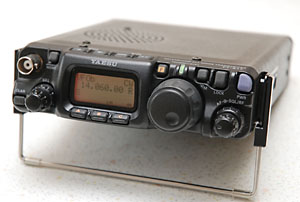So you have your licence – what’s next?
 Welcome to the wonderful word of amateur radio! You have just joined thousands of like-minded amateurs who are engaged in one of the most fascinating hobbies on the planet.
Welcome to the wonderful word of amateur radio! You have just joined thousands of like-minded amateurs who are engaged in one of the most fascinating hobbies on the planet.
We bet you can’t wait to get on the air – and you’d probably like some help on choosing a radio, antenna and other accessories, which is why we built this part of the web site.
If you have just gained your foundation licence one of your first steps might be to investigate moving on to an intermediate or advanced licence. By doing so you will get access to higher power limits and also extend your knowledge of amateur radio.
You might also want to join your local radio club – we have a page devoted to doing just that.
But in the meantime let’s look at just three things you could do with your new licence.
Make a contact on 2m FM
Two metres is a great band for getting to know the locals. With a maximum range of around 5-50 miles under normal conditions, you stand a great chance of finding someone to talk to. Most areas are served by repeaters, but if not a CQ on the calling frequency of 145.500 MHz might rustle up up a contact.
Use two metres (144 MHz) SSB
If you can put up a horizontal beam antenna you can take part in the world of 2m (144 MHz) SSB.
SSB, or Single Side Band, carries further than FM and will allow you to make contacts up to, perhaps, 100 miles under what we call “flat” conditions. But when the weather conditions are right (and they are usually associated with high-pressure systems) we can get a “lift” or tropospheric enhancement, to give it its proper name.
When this happens signals can pour in from even further afield. It is quite possible to work the length of the country on 2m SSB and contacts into Europe are possible – even if you are only running a few Watts.
The 2m band also has beacons that transmit continuously so you can hear if conditions are favourable for long-distance communication. In the UK the most famous one is GB3VHF, which is situated in Kent, and transmits on 144.430MHz.
But often you can hear beacons from the Netherlands, France, Germany and beyond. The fun of 2m is knowing when the good conditions might occur and seeing how far you can get with your signals.
Get on the HF bands
UK radio amateurs have access to a large number of bands and each have their own characteristics. For example, 80m (3.5 MHz) and 40m (7 MHz) are useful during the day for contacts around the UK and Europe. While 80m is better for this kind of activity near solar minimum, you might be better off on 40m when the sun is more active.
Once the sun sets, however, both bands start to open up to contacts at longer distances. In fact, 40m is a fantastic band, offering you everything from chats around the UK to real worldwide DX – although it can get crowded at times.
If we look at another band – 20m or 14 MHz – it is very different. During the day you might hear stations from all around the world if conditions are good enough and there are some sunspots. In the morning you might hear stations from the east of you and around lunchtime they might be rolling in from the south. But in the afternoon, depending upon the time of year and conditions, you might hear the USA or South America.
In the winter, especially at sunspot minimum, you may find the band closes shortly after sunset. But in the summer, and at sunspot maximum, the band can remain open 24 hours a day – it is all part of what makes HF propagation interesting.
Looking further up the dial we come across 10m (28 MHz). At sunspot minimum it can be dead for days on end. But near sunspot maximum it can come alive with incredibly strong signals from around the globe during the day.
The great thing about 28 MHz is that the antennas can be quite small – a half-wave dipole is only about 5m long (16.5ft). Even with such a simple antenna it can be easy to work across the Atlantic to the USA or down into South Africa.
And if you only have a foundation licence your 10W can go a long way indeed.
Other pages in this section – First Steps:












